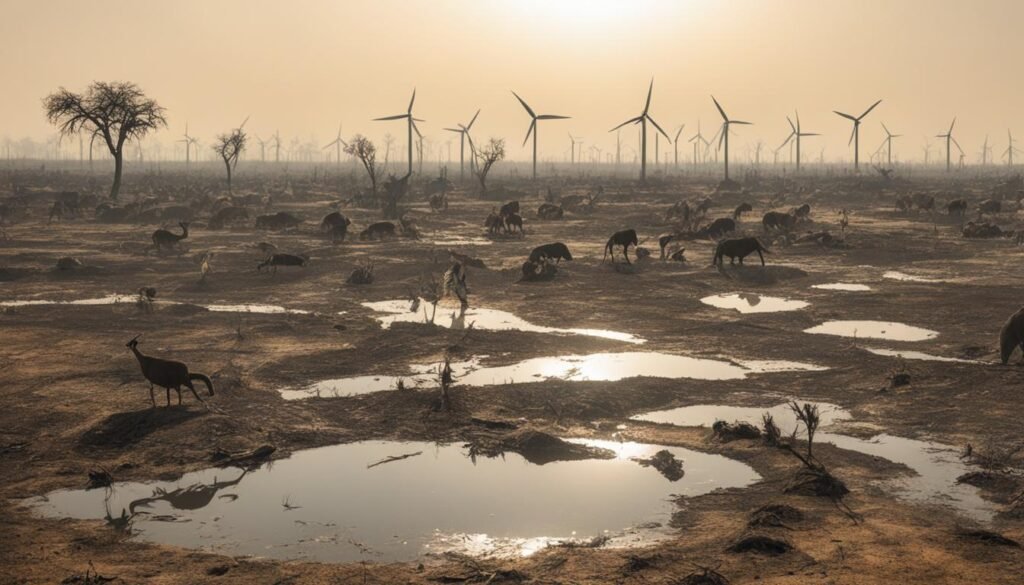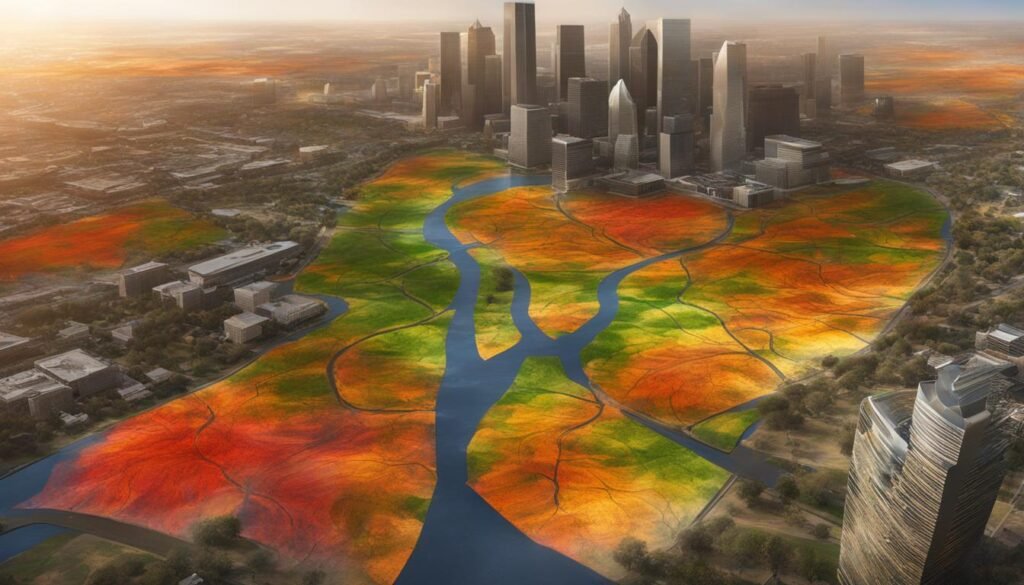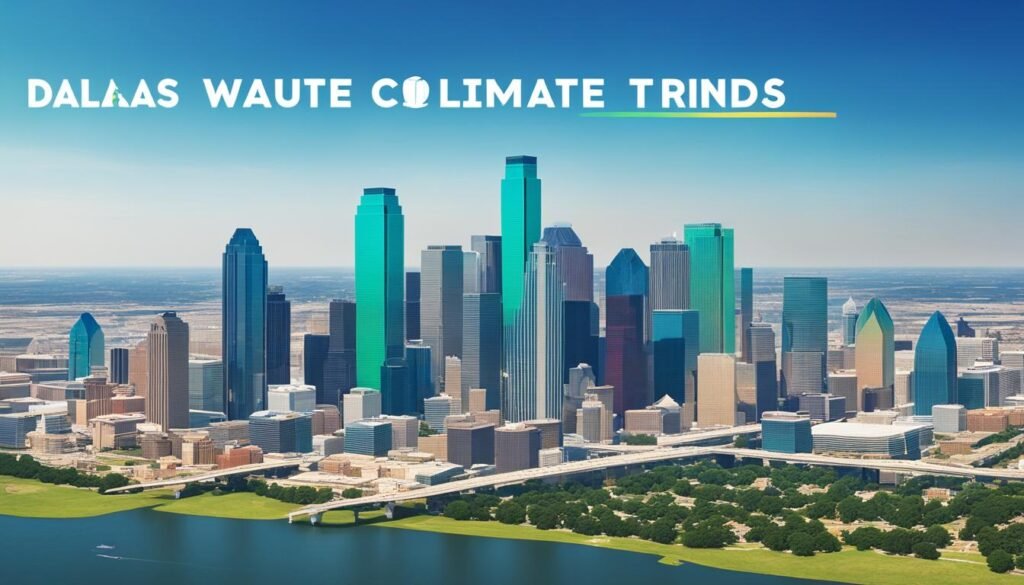Welcome to our Dallas Weather & Climate Guide for 2023! Whether you’re a local resident or planning a visit, it’s essential to stay informed about the weather conditions in Dallas. In this guide, we’ll provide you with valuable insights into Dallas weather forecasts, climate data, and what you can expect this winter.
Key Takeaways:
- Stay up-to-date with the latest Dallas weather forecasts for accurate information.
- The Climate Prediction Center predicts wetter than average conditions for Texas through February.
- El Niño is expected to influence the weather patterns, bringing wetter conditions across the southern U.S.
- While the forecast suggests near-normal average temperatures, be prepared for potential fluctuations.
- Wetter conditions may help alleviate drought conditions and reduce the risk of wildfires.
What to Expect This Winter
The 2023-24 winter outlook from the Climate Prediction Center (CPC) indicates that Dallas can expect wetter than average conditions throughout the season. While the forecast does not suggest extreme winter weather with frozen precipitation, it is important to be prepared for the wetter conditions. Let’s take a closer look at what to anticipate in terms of average temperatures and overall weather conditions in Dallas this winter.
The average temperatures during the winter months in North Texas typically range from the upper 50s as highs to the upper 30s as lows. This means that Dallas residents can anticipate relatively mild winter temperatures. It is important to note that these are average temperatures, and there may still be occasional fluctuations that can result in colder or warmer days.
Winter Temperature Range in Dallas:
| Month | Average High Temperature (°F) | Average Low Temperature (°F) |
|---|---|---|
| December | Upper 50s | Upper 30s |
| January | Upper 50s | Upper 30s |
| February | Upper 50s | Upper 30s |
Overall, the forecast suggests near-normal temperatures for Dallas this winter. While it’s always a good idea to stay updated with the latest weather forecasts and conditions, it’s reassuring to know that Dallas is not expected to experience extreme cold or freezing temperatures during the winter months.
Stay prepared and stay informed with the latest weather updates as the winter season progresses.
Impact on Drought Conditions

The wetter than average conditions predicted for Texas during the winter months may help alleviate drought conditions. The prolonged drought in the region has resulted in strained water resources, such as soils, vegetation, aquifers, rivers, creeks, and lakes. The anticipated rainfall can provide relief to the hydrologic cycle and reduce the risk of devastating wildfires, which have been a concern in recent years.
| Drought Indicators | Current Level | Impact on Water Resources |
|---|---|---|
| Soil Moisture | Extremely Dry | Depleted moisture content affects agriculture and vegetation. |
| Aquifers | Lowering Water Levels | Decreased availability of groundwater for consumption. |
| Rivers & Creeks | Reduced Flow | Negative impact on water supply and aquatic habitats. |
| Lakes | Low Water Levels | Affected recreational activities and water reservoir capacity. |
The Importance of Rainfall
The predicted above-average precipitation can have a positive impact on these drought indicators. Ample rainfall will recharge the soil moisture, replenish aquifers, restore flow in rivers and creeks, and raise water levels in lakes. This will not only help to sustain water resources but also improve ecological balance and support various sectors, including agriculture, municipal supply, and recreation.
In the words of hydrologist Dr. Sarah Carter, “The much-needed rainfall can serve as a lifeline for Texas, mitigating the detrimental effects of the prolonged drought and offering hope for a water-secure future.”
Reducing the Risk of Wildfires
The increased moisture from the forecasted wetter conditions in winter can also reduce the risk of devastating wildfires. Drier conditions and drought-stricken landscapes provide favorable conditions for wildfires to spread rapidly. By moistening the vegetation and reducing dry fuel sources, the anticipated rainfall can help mitigate the threat of wildfires, safeguarding communities and ecosystems from significant damages.
As the chart below illustrates, Dallas has experienced a rising trend in wildfires due to the recent drought conditions:
| Year | Number of Wildfires |
|---|---|
| 2017 | 194 |
| 2018 | 264 |
| 2019 | 392 |
| 2020 | 521 |
| 2021 | 663 |
The anticipated rainfall is expected to reverse this trend, providing relief and reducing the incidence of devastating wildfires.
Long-Range Weather Forecasts
When planning for the future, long-range weather forecasts are a valuable tool. These forecasts provide a general outlook of anticipated weather conditions for specific periods, allowing individuals to make informed decisions. Let’s take a closer look at the long-range weather forecasts for January and February 2024 in Texas-Oklahoma.
January Forecast
The long-range weather forecast for the first week of January 2024 suggests flurries in the northern regions and rain in the southern regions of Texas-Oklahoma. As the month progresses, rainy periods are expected, with some snowfall in the north. Temperatures will be cold, and there will be sporadic sunny days.
February Forecast
In February 2024, sunny days are anticipated, accompanied by rain and snow showers in the northern regions. Isolated showers are predicted for the southern regions. Temperatures may vary, but overall, the weather will be relatively mild.
Stay updated with the latest long-range weather forecasts to plan your activities accordingly.
The 2024 Old Farmer’s Almanac
The 2024 edition of The Old Farmer’s Almanac provides a 12-month weather report for November 2023 to October 2024. It predicts colder than normal winter conditions in the north and warmer conditions in the south. Precipitation and snowfall are expected to be above normal, with the best chances for snow occurring in late December and late January. The Almanac also forecasts cooler than normal temperatures during the summer months, with above-normal rainfall and the possibility of tropical storms in mid-July and late August.
| Month | Temperature | Precipitation |
|---|---|---|
| November | Varies by location | Above normal |
| December | Colder than normal | Above normal (chance of snow) |
| January | Colder than normal | Above normal (chance of snow) |
| February | Colder than normal | Above normal |
| March | Varies by location | Normal |
| April | Varies by location | Normal |
| May | Varies by location | Normal |
| June | Varies by location | Normal |
| July | Warmer than normal | Above normal (possible tropical storms) |
| August | Warmer than normal | Above normal (possible tropical storms) |
| September | Varies by location | Normal |
| October | Varies by location | Normal |
The Influence of El Niño

El Niño, a climate pattern characterized by warmer-than-normal surface waters in the eastern Pacific Ocean, can have a significant impact on weather patterns in the U.S. South and beyond. This phenomenon plays a role in shaping the winter climate in various regions, including Dallas, Texas. The presence of El Niño typically brings wet and cool winters to the area, which can have implications for local climate trends and conditions.
Texas State Climatologist John Nielsen-Gammon explains that El Niño’s influence can help alleviate drought conditions in Dallas and the surrounding areas. The wetter than average conditions associated with El Niño can provide much-needed relief to the region, with beneficial effects on water resources, such as soils, vegetation, aquifers, rivers, creeks, and lakes. Additionally, the cool temperatures brought by El Niño during the winter months can help mitigate the risk of devastating wildfires that have been a concern in recent years.
However, it’s important to note that the influence of El Niño is not the only factor at play. Climate change is also impacting weather patterns in Dallas and the broader region. With the overall warming trend attributed to climate change, the cooler conditions brought by El Niño may be offset to some extent. As temperatures continue to rise due to climate change, it’s crucial to consider the long-term effects on climate trends in Dallas and adapt accordingly.
Expert Insights
“El Niño is known for its ability to bring wet and cool winters to Texas, which can be beneficial for alleviating drought conditions. However, the impact of El Niño needs to be considered in the context of climate change, which is making temperatures warmer overall.”
– John Nielsen-Gammon, Texas State Climatologist
The Influence of El Niño on Dallas Climate Trends
To better understand the influence of El Niño on Dallas climate trends, let’s take a look at the following table showcasing temperature and precipitation patterns during El Niño years compared to non-El Niño years in the city.
| El Niño Years | Temperature | Precipitation |
|---|---|---|
| 2015-2016 | Warmer than average | Wetter than average |
| 2009-2010 | Warmer than average | Wetter than average |
| 2002-2003 | Cooler than average | Wetter than average |
| 1997-1998 | Warmer than average | Wetter than average |
As demonstrated in the table, El Niño years in Dallas have shown a tendency towards above-average precipitation, with some variations in temperature. These patterns highlight the important role that El Niño plays in shaping climate trends in the region and the potential impact on local weather conditions.
While El Niño represents a significant influence on winter climate in Dallas, it’s important to remember that climate change is also at play. The warming trend associated with climate change brings additional considerations when analyzing long-term climate patterns. By understanding the complex interaction between El Niño and climate change, we can better comprehend the evolving climate trends in Dallas and prepare for the future.
Uncertainty and the Impact of Climate Change
While the outlook for wetter-than-average conditions in Texas during the winter months is promising, there is still some uncertainty in temperature projections. The atmospheric steering flow and its evolution across the southwest U.S./northwest Mexico during early winter are factors that contribute to this uncertainty. It’s important to stay updated with the latest forecasts as changes, if any, would be minor and unlikely to result in dramatic pattern alterations. Climate change is also influencing Texas winters, with expectations of warmer temperatures and less severe extreme cold air outbreaks.
Unique Factors and Warm Ocean Temperatures

This winter in Dallas will be influenced by two significant factors: a moderately strong El Niño and the ongoing warming trend caused by climate change. These factors will shape the weather patterns and conditions experienced in the region.
The University of Texas at Austin’s Zong-Liang Yang, an expert in climate science, has provided insights into the development and impact of El Niño. He explains that El Niño began forming in the summer and is expected to reach its peak intensity in December. El Niño is a climate phenomenon characterized by warmer-than-normal surface waters in the eastern Pacific Ocean. Its presence often leads to shifts in weather patterns across the U.S. South, including Texas.
In addition to El Niño, the global sea surfaces have reached record-high temperatures. This rise in ocean temperatures is a result of both climate change and the El Niño event. The warming of the ocean has far-reaching implications for weather systems worldwide, including Dallas and the surrounding areas.
While El Niño typically brings wetter winters to the region, the concurrent warming trend caused by climate change may counter this effect. As temperatures continue to increase due to climate change, Dallas may experience a warmer-than-normal winter season. This could have implications for the local climate, affecting not only temperature but also precipitation patterns.
The combination of El Niño and climate change adds complexity to the weather patterns expected this winter. While wetter conditions can be expected due to El Niño, the warming trend may moderate the overall impact on temperature. It is important to stay updated with the latest weather forecasts and prepare accordingly to adapt to these unique factors influencing Dallas’s weather trends.
Potential Winter Scenarios
While the winter forecast for Dallas predicts wetter than average conditions, there is still a small chance, roughly 1 in 4, that the season could end up drier than normal. This highlights the need to remain prepared and adaptable to the various possibilities that winter weather may bring. Taking advantage of El Niño periods, which typically bring wet and cool winters to the region, can help mitigate the impact of dry scenarios.
“Despite the predicted wetter conditions, it’s essential to stay alert and informed about ongoing weather patterns,” advises meteorologist Sarah Thompson. “Power outages and extreme cold outbreaks, such as Winter Storm Uri, are generally less common during El Niño winters. However, it’s always important to remain prepared for any unexpected weather events during the winter season.”
To further understand the potential winter scenarios in Dallas, let’s explore the contrasting factors that could influence the weather:
| Scenario | Chance |
|---|---|
| Wetter than average winter | 75% |
| Drier than normal winter | 25% |
Based on the prevailing conditions, the likelihood of a wetter than average winter outweighs the chances of a drier season. However, it’s crucial to remain prepared for any potential deviations from the forecasted scenario.
Staying informed about the latest Dallas weather updates and trends is key to adapting to changing conditions and effectively planning for the season. Regularly reviewing the Dallas weather forecast can provide valuable insights on potential shifts in weather patterns and the need for adjustments in daily routines and preparedness measures.
By keeping a proactive approach, Dallas residents can stay ahead of any potential challenges and make the most out of the winter season, regardless of the specific weather scenarios that unfold.
Adapting to Changing Weather Patterns

Climate change in Dallas is leading to ongoing shifts in weather patterns and increasing the occurrence of extreme events. As temperatures rise, Texas winters are expected to become warmer overall, with less severe extreme cold outbreaks. This changing climate also brings unpredictable weather swings, fluctuating from one extreme to another, making it challenging to anticipate and prepare for specific weather conditions.
To mitigate potential risks and impacts, it is crucial for individuals and communities in Dallas to adapt to these changing weather conditions. By understanding climate trends in Dallas and staying informed about the latest Dallas climate data, residents can take proactive measures to protect themselves and their properties.
Adapting to changing weather patterns can involve various strategies:
- Stay updated with weather forecasts and warnings to anticipate extreme weather events.
- Implement energy-efficient practices to reduce greenhouse gas emissions and combat climate change.
- Invest in infrastructure improvements, such as building resilient homes and increasing green spaces, to enhance climate resilience.
- Engage in water conservation practices to effectively manage water resources in the face of changing rainfall patterns.
- Implement sustainable agriculture practices to adapt to changing growing conditions and ensure food security.
- Support local and regional initiatives aimed at addressing climate change and its impacts.
“With climate change, it is essential for individuals, organizations, and governments to prioritize adaptation efforts,” says climate scientist Dr. Emily Davis. “By adapting to changing weather patterns, we can reduce vulnerability, minimize risks, and build more resilient communities.”
As Dallas continues to experience the effects of climate change, it is crucial for individuals and the city as a whole to embrace adaptation measures. By proactively addressing the challenges posed by changing weather patterns, Dallas can enhance its resilience, protect its residents, and ensure a sustainable future.
Key Takeaways:
• Climate change in Dallas leads to ongoing shifts in weather patterns and extreme events.
• Winters are expected to become warmer with less severe extreme cold outbreaks.
• Adapting to changing weather patterns is crucial for mitigating risks and impacts.
• Strategies include staying updated with forecasts, implementing energy-efficient practices, investing in resilient infrastructure, conserving water, adopting sustainable agriculture, and supporting climate initiatives.
Conclusion
The 2023-24 winter outlook for Dallas indicates that the city can expect wetter than average conditions through February, thanks to the presence of El Niño. This forecast brings hope for alleviating drought conditions and reducing the risk of wildfires, which have been a significant concern in recent years. While there is still some uncertainty in temperature projections, the overall trend suggests near-normal average temperatures for Dallas during the winter months.
As climate change continues to influence weather patterns, it is crucial to stay prepared and informed about the latest weather forecasts. Weather patterns in Dallas are evolving, and it’s important to adapt to these changes. The wetter than average conditions predicted for the winter months offer an opportunity to replenish water resources and mitigate the impacts of drought. By staying proactive and staying updated with the latest weather conditions, we can better navigate the changing climate and its effects on Dallas weather.
As we move forward, it is essential to acknowledge the influence of climate change on Dallas weather conditions. Weather patterns in the city are shifting, and we must be prepared for more unpredictable swings from one extreme to another. Adapting to these changing weather patterns is crucial to mitigate potential risks and protect ourselves and our communities. By understanding the weather trends in Dallas and staying informed, we can make informed decisions and take appropriate actions to ensure our safety and well-being.








